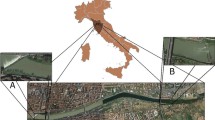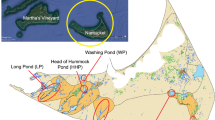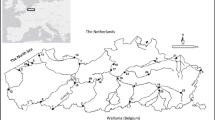Abstract
This study investigated the effects of age and length on mercury contamination in four fish species; yellow-eye mullet (Aldrichetta forsteri), black bream (Acanthopagrus butcheri), sand flathead (Platycephalus bassensis) and sea-run brown trout (Salmo trutta) from the Derwent Estuary, Tasmania, Australia, and examined the implications of these findings for public health monitoring. Mean mercury levels exceeded the Food Standards Australia and New Zealand maximum permitted level (0.5 mg kg−1) for all species except yellow-eye mullet. Mean levels in black bream were significantly higher (p < 0.05) than other species and consequently are a particular concern for human health. Regional differences (p < 0.05) in mercury levels in sand flathead were not obviously correlated with metal levels in the sediments. However, age and length significantly (p < 0.05) influenced mercury levels in brown trout and sand flathead, with age being more strongly related to intraspecies differences. In addition, movement and distribution within the estuary and trophic status appeared to be important factors in contribution to interspecific variation. Consequently, a sound understanding of fish life history and biology is important in identifying species which may be susceptible to accumulating mercury and hence pose a potential threat to human health.



Similar content being viewed by others
References
Asuquo, F. E., Ewa-Oboho, I., Asuquo, E. F., & Udo, P. J. (2004). Fish species used as biomarker for heavy metal and hydrocarbon contamination for Cross River, Nigeria. The Environmentalist, 24, 29–37.
Beamish, R. J., & Fournier, D. A. (1981). A method for comparing the precision of a set of age determinations. Canadian Journal of Fisheries and Aquatic Sciences, 38, 982–983.
Blevins, R. D., & Pancorbo, O. C. (1986). Metal concentrations in muscle of fish from aquatic systems in east Tennessee, USA. Water, Air, and Soil Pollution, 29, 361–371.
Bloom, H., & Ayling, G. M. (1977). Heavy metals in the Derwent Estuary. Environmental Geology, 2, 3–22.
Burger, J. (2007). Heavy metals in pacific cod (Gadus macrocephalus) from the aleutians: location, age, size, and risk. Journal of Toxicology and Environmental Health. Part A, 70, 1897–1911.
Calta, M., & Canpolat, O. (2006). The comparison of three cyprinid species in terms of heavy metals accumulation in some tissues. Water Environment Research, 78, 548–551.
Campbell, K. R. (1994). Concentrations of heavy metals associated with urban runoff in fish living in stormwater treatment ponds. Archives of Environmental Contamination and Toxicology, 27, 352–356.
Carvalho, M. L., Santiago, S., & Nunes, M. L. (2005). Assessment of the essential element and heavy metal content of edible fish muscle. Analytical and Bioanalytical Chemistry, 382, 426–432.
Curtis, T. D., & Shima, J. S. (2005). Geographic and sex-specific variation in growth of yellow-eyed mullet, Aldrichetta forsteri, from estuaries around New Zealand. New Zealand Journal of Marine and Freshwater Research, 39, 1277–1285.
Dix, T. G., Martin, A., Ayling, G. M., Wilson, K. C., & Ratkowsky, D. A. (1975). Sand flathead (Platycephalus bassensis) an indicator species for mercury pollution in Tasmanian waters. Marine Pollution Bulletin, 6, 142–143.
Eustace, I. J. (1974). Zinc, cadmium, copper and manganese in species of finfish and shellfish caught in the Derwent Estuary, Tasmania. Australian Journal of Marine and Freshwater Research, 25, 209–220.
Ewing, G. P., Lyle, J. M., Murphy, R. J., Kalish, J. M., & Ziegler, P. E. (2007). Validation of age and growth in a long-lived temperate reef fish using otolith structure, oxytetracycline and bomb radiocarbon methods. Marine and Freshwater Research, 58, 1–12.
Fabris, G. J., Theodoropoulos, T., Sheehan, A., & Abbott, B. (1999). Mercury levels and organochlorines in black bream, Acanthopagrus butcheri, from the Gippsland Lakes, Victoria, Australia: evidence for temporal increases in mercury levels. Marine Pollution Bulletin, 38, 970–976.
FSANZ (Food Standards Australia and New Zealand). (2004). Regulations for mercury in fish. <http://www.foodstandards.gov.au/newsroom/factsheets/factsheets2004/mercuryinfishfurther2394.cfm>. [accessed 2008 Feb 2]
Graynoth, E. (1996). Determination of the age of Brown and Rainbow trout in a range of New Zealand lakes. Marine and Freshwater Research, 47, 749–756.
Green, G., Coughanowr, C. (2003). State of the Derwent Estuary 2003: a review of pollution sources, loads and environmental quality data from 1997–2003. Derwent Estuary Program, DPIWE, Tasmania.
Han, B. C. (1998). Estimation of target hazard quotients and potential health risks for metals by consumption of seafood in Taiwan. Archives of Environmental Contamination and Toxicology, 35, 711–720.
Harada, M. (1995). Minamata disease: methylmercury poisoning in Japan caused by environmental pollution. Critical Reviews in Toxicology, 25, 1–24.
Hindell, J. S., Jenkins, G. P., & Womersley, B. (2008). Habitat utilization and movement of black bream Acanthopagrus butcheri (Sparidae) in an Australian estuary. Marine Ecology Progress Series, 336, 219–229.
Hornung, H., Krom, M. D., Cohen, Y., & Bernhard, M. (1993). Trace metal content in deep-water sharks from the eastern Mediterranean Sea. Marine Biology, 115, 331–338.
Jones, B. G., Chenhall, B. E., Debretsion, F., & Hutton, A. C. (2003). Geochemical comparisons between estuaries with non-industrialised and industrialised catchments: the Huon and Derwent River estuaries, Tasmania. Australian Journal of Earth Sciences, 50, 653–667.
Jordan, A. R. (2001). Reproductive biology, early life-history and settlement distribution of sand flathead (Platycephalus bassensis) in Tasmania. Marine and Freshwater Research, 52, 589–601.
Jordan, A. R., Mills, D. M., Ewing, G., & Lyle, J. M. (1998). Assessment of inshore habitats around Tasmania for life-history stages of commercial finfish species. FRDC Final Report. University of Tasmania, Tasmanian Aquaculture and Fisheries Institute.
Lyle, J. M. (2005). 2000/01 Survey of recreational fishing in Tasmania. Tasmanian Aquaculture and Fisheries Institute. Technical Report.
Lyle, J. M., Tracey, S. R., Stark, K. E., & Wotherspoon, S. (2009) 2007–08 survey of recreational fishing in Tasmania. Tasmanian Aquaculture and Fisheries Institute Report.
MacKay, N. J., Kazacos, M. N., Williams, R. J., & Leedow, M. I. (1975). Selenium and heavy metals in black marlin. Marine Pollution Bulletin, 6, 57–61.
Mason, R. P., Reinfelder, J. R., & Morel, F. M. M. (1995). Bioaccumulation of mercury and methylmercury. Water, Air, and Soil Pollution, 80, 915–921.
Morison, A. K., Coutin, P. C., & Robertson, S. G. (1998). Age determination of black bream, Acanthopagrus butcheri (Sparidae), from the Gippsland Lakes of south-eastern Australia indicates slow growth and episodic recruitment. Marine and Freshwater Research, 49, 491–498.
Park, J. G., & Curtis, L. R. (1997). Mercury distribution in sediments and bioaccumulation by fish in two Oregon reservoirs: point-source and nonpoint-source impacted systems. Archives of Environmental Contamination and Toxicology, 33, 423–429.
Pourang, N. (1995). Heavy metal bioaccumulation in different tissues of two fish species with regards to their feeding habits and trophic levels. Environmental Monitoring and Assessment, 35, 207–219.
Ratkowsky, D. A., Dix, T. G., & Wilson, K. C. (1975). Mercury in fish in the Derwent Estuary, Tasmania, and its relation to the position of the fish in the food chain. Australian Journal of Marine and Freshwater Research, 26, 223–231.
Sarre, G. A., Platell, M. E., & Potter, I. C. (2000). Do the dietary compositions of Acanthopagrus butcheri in four estuaries and a coastal lake vary with body size and season and within and amongst these water bodies? Journal of Fish Biology, 56, 103–122.
Sorensen, E. M. B. (1991). Metal poisoning in fish. Boston: CRC Press.
Wang, W. X. (2002). Interactions of trace metals and different marine food chains. Marine Ecology Progress Series, 243, 295–309.
Wiener, J. G., Krabbenhoft, D. P., Heinz, G. H., & Scheuhammer, A. M. (2003). Ecotoxicology of mercury. In D. J. Hoffman, B. A. Rattner, G. A. Burton, & J. Cairns (Eds.), Handbook of ecotoxicology (2nd ed., pp. 409–443). New York: Lewis Publishers.
Acknowledgement
This work was funded by Nystar Pty Ltd. and a Fishwise Community Grant. We would like to thank all those who assisted us in the field, notably Mr. L. Mackenzie, Mr. M. Stalker and Mr. A. Hunt. We are grateful to Dr. A. Featherstone, Mr. S. Black and Dr. D. Norman from Analytical Services Tasmania for their assistance with the metal analyses. Thanks must also go to Mr. G. Ewing for his practical and theoretical advice on fish processing and aging and to Mr. D. Padula for his guidance with respect to metal residues monitoring and analysis.
Author information
Authors and Affiliations
Corresponding author
Rights and permissions
About this article
Cite this article
Verdouw, J.J., Macleod, C.K., Nowak, B.F. et al. Implications of Age, Size and Region on Mercury Contamination in Estuarine Fish Species. Water Air Soil Pollut 214, 297–306 (2011). https://doi.org/10.1007/s11270-010-0424-y
Received:
Accepted:
Published:
Issue Date:
DOI: https://doi.org/10.1007/s11270-010-0424-y




